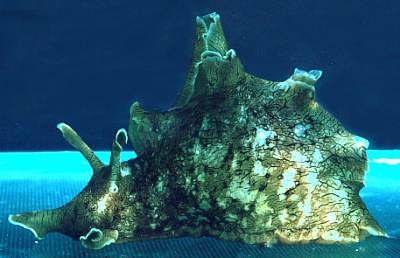
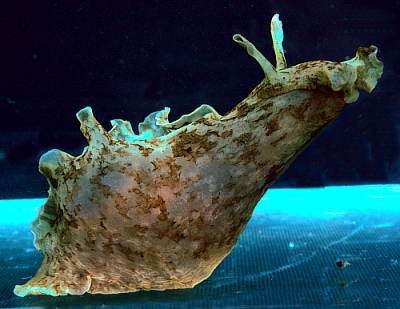
Aplysia sydneyensis
Sowerby, 1869
Order: ANASPIDEA
Superfamily: APLYSIOIDEA
Family: Aplysiidae
DISTRIBUTION
This species has never been well defined so I am hesitant to accept all previous identifications. Specimens which seem to be this species are reported from southern Queensland, New South Wales, Tasmania, Victoria in southeastern Australia.
PHOTO
Two animals showing colour variation. Long Reef, Sydney, NSW, Australia. Many animals in tide pools often in mating pairs. 19 September 1978. AM C111827. Photo: John Fields.
Aplysia sydneyensis was originally described from a shell, and as Eales (1960) comments it has never been clearly defined. Eales, and subsequent workers have based their interpretation of the species on specimens identified by Australian zoologists as A. sydneyensis. This is a somewhat unsatisfactory situation, but it applies to many Aplysia names. We can either declare almost all species names in the genus to be impossible to identify, or persevere with in validating certain of the many species names available through usage. It is of course possible that the animal we are calling A. sydneyensis has a much wider distribution than is presently recognised. If so, there may be an earlier name for this species.
The body is translucent clear with a blotches of white and various shades of brown. Sometimes there can be a greenish tinge. There can sometimes be a pattern of dark brwon or blackish lines forming a reticulate pattern over the head and parapodia, and sometimes, as in the upper photo, there can be scattered dark brown rings. The mantlel covering the shell has a characteristic pattern of rays radiating out from the foramen. The rays can be dark brown lines, rows of spots, or in some cases white bands. The mantle foramen is small, sometimes contracted into a raised papilla. It grows to approx 150mm in length. It produces a deep purple coloured ink, as distinct from the wine red coloured ink of Aplysia dactylomela.
References:
• Bebbington, A. (1977) Aplysiid species from Eastern Australia with notes on the Pacific Ocean Aplysiomorpha (Gastropoda: Opisthobranchia). Transactions of the Zoological Society of London, 34: 87-147.
• Eales, N.B. (1960) Revision of the world species of Aplysia (Gastropoda, Opisthobranchia). Bulletin of the British Museum (Natural History), Zoology, 5(10): 267-404.
• Sowerby, G.B. (1869) Aplysia In: Conchologia Iconica, 17. Reeve: London.
Rudman, W.B., 2002 (November 27) Aplysia sydneyensis Sowerby, 1869. [In] Sea Slug Forum. Australian Museum, Sydney. Available from http://www.seaslugforum.net/find/aplysydn
Related messages
Aplysia sydneyensis - chain mating
January 31, 2007
From: Leanne & David Atkinson
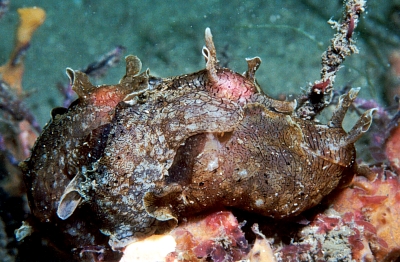
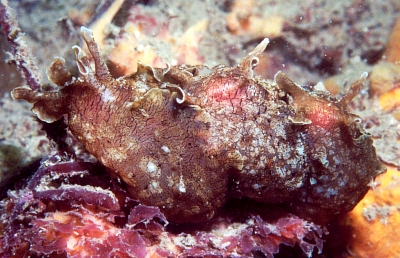
Dear Bill,
Re: message 19115 from Tess
Here are left and right side photos we took of Sea Hares mating at The Pipeline which is only a few kilometres east of Corlette in Port Stephens.For non divers it is between Dutchies Beach and the western side of D'Albora Marina Nelson Bay.
Since they're mating we'd assume they are adults? These were relatively small in comparison to the ones we see commonly in Port Stephens which we assume are Aplysia extraordinaria.We wondered whether these were Aplysia juliana or Aplysia extraordinaria. Our attentions flashing away with cameras didn't disturb them and consequently we don't know what colour ink they produce. Can you identify them for us please Bill?
Locality: The Pipeline, Nelson Bay, Port Stephens, 8 metres, New South Wales, Australia , Pacific, 06 November 2005, Sandy silty bottom scattered sponges, algae, ascidians and soft corals. Length: approximately 90 mm. Photographer: Leanne & David Atkinson.
Regards,
Leanne & David Atkinson
atk@hunterlink.net.au
Atkinson, L. & D., 2007 (Jan 31) Aplysia sydneyensis - chain mating. [Message in] Sea Slug Forum. Australian Museum, Sydney. Available from http://www.seaslugforum.net/find/19204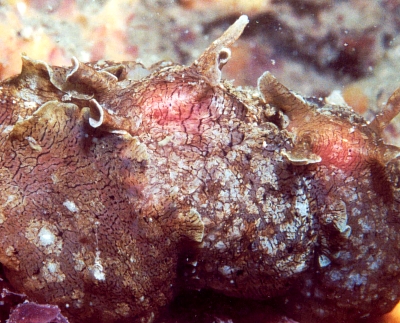
Dear Leanne & David,
Sea hares and cephalaspidean 'bubble shells' often mate in chains like this [see Fact Sheet]. As you guessed, this is not A. extraordinaria, but the smaller, non-swimming, Aplysia sydneyensis. Apart from size, A. extraordinaria has much larger parapodia, in proportion to the rest of the body. The three animals in your chain well illustrate colour variation in the species. In general there is a translucent brownish background colour with a pattern of brown reticulate lines and white patches. In the close-up alongside, the colour of the animal on the left is dominated by the brown reticulation, and in the animal on the right the white patches dominate. However in the animal in the middle has both white patches and reticulate pattern.
The reddish-pink patch on the head of each animal, is caused by the bright red buccal bulb showing through the body wall. The buccal bulb is the highly muscular organ that contains the jaws and radular teeth.
Best wishes,
Bill Rudman
Aplysia sydneyensis from eastern Australia
September 14, 2005
From: Sascha Schulz
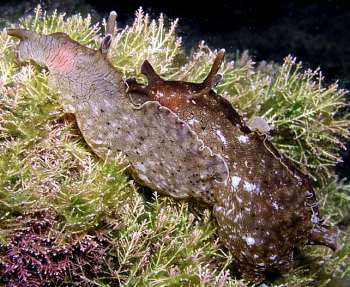
Dear Bill,
I found these animals - a mating pair? in a rockpool at Kiama, just south south of Sydney, NSW. July 2005
Are they Aplysia extraordinaria?
Sascha Schulz
ss31@dodo.com.au
Schulz, S., 2005 (Sep 14) Aplysia sydneyensis from eastern Australia. [Message in] Sea Slug Forum. Australian Museum, Sydney. Available from http://www.seaslugforum.net/find/14760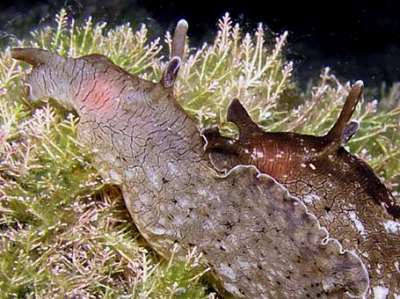
Dear Sascha,
They are Aplysia sydneyensis, which ranges in colour from almost translucent to quite dark brown. Your two mating animals exhibit the range of background colour found in this species, but you will see they bot have the colour pattern of fine reticulate dark lines and scattered whitish or translucent patches.
Best wishes,
Bill Rudman
Aplysia sydneyensis from eastern Australia
August 5, 2005
From: Francis Hawkshaw
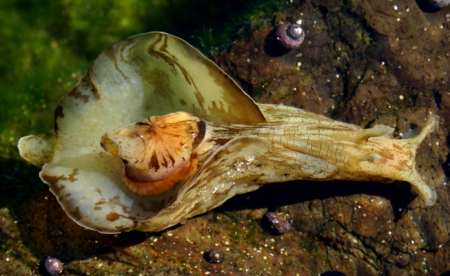
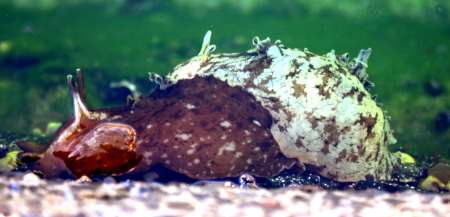
Hi!
I have sent you these photos taken 1st August 2005 and 2nd August 2005, these photos were taken at Kiama on the south coast of New South Wales [eastern Australia]. They were taken at the saltwater rock swimming pool ... and are part of my collection of 60 plus photos of sea slugs.
There are a lot of sea slugs at this time of the year feeding and breeding in the moss and green weed in the pool, there seems to be several species as there is a marked variation in colour .. .there are few human swimmers and the winter sea water is very clear so this may affect the breeding cycle .
The photos were taken from above the waterline .
If possible I would like this species identified and would like more information on them. Are there male and female and does the sex (Male or female) depict the colour or are they hermaphrodites ? Are they like chameleons and can change colour with the environment or light. In the upper photo I see an area on the back with what appears to be the spaghetti like egg casings and eggs - is this usual?
In the lower photo eggs it is possible to see the eggs in the spaghetti-like casings plus two different coloured slugs, Is it usual for them to place these eggs at just below the waterline so that they have some access to sunlight?
Some of the sea slugs seem small (possibly juveniles), some seem large so is there a size range?
I would be happy to share the sea slug images with others so look forward to your reply.
Francis Hawkshaw (Mrs)
Kiama Heights, 2533.
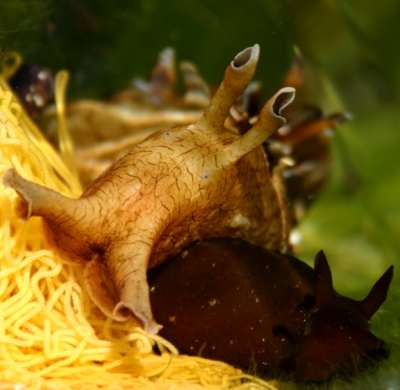
Dear Francis,
Thanks for this interesting series of photos of the Sea Hare Aplysia sydneyensis. If you go to the General Topics index you will find a list of pages on Sea Hares which should answer most of your questions in more detail than I will here. In brief, all sea slugs are hermaphrodites. In your middle photo there are two animals mating, the front one acting as female and the back one as male, but as you will see on the mating chains page, they often form chains where animals act as male and female simultaneously. As far as I know they don't change colour, at least not quickly as a chameleon. There is some evidence to suggest that some Sea Hares change colour depending on the algae they are feeding on, but we need more research before we can say whether that is so.
Concerning size variation. It is possible that your have adults and juveniles together, and it is also possible you may have more than one species present. I suspect the datr brown animal in your lower photo is Aplysia juliana, but I can't see enough to be sure. The things you can see in the upper photo are the organs of the mantle cavity, mainly the orange gill and the flap of tissue that encloses the small flattened shell these animals still retain.
Best wishes,
Bill Rudman
Colour form? of Aplysia juliana
November 12, 2003
From: Paul Furneaux
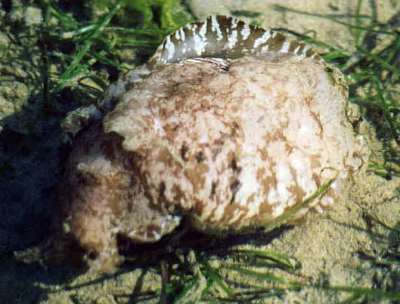
Dear Bill,
I came across this individual sea hare back in August when there was a large group of Aplysia juliana breeding in a relatively confined area in Tauranga Harbour [New Zealand]. At first I thought that it was a different species but from what I read about Aplysia juliana it has many colour forms and so I assumed that this was just a different colour variant, but I would appreciate your opinion on this. It was the same size (about 250mm long) as the other very dark "green/black" form which was the only colour that I saw in hundreds of individuals over July - August - September breeding period. (By early October all of these individuals had completely disappeared )
The egg string of this individual was a much lighter colour than the usual egg string, more of a pale cream than the intensely bright yellow of the dark colour forms. I observed this individual once only (7th August) in three to four months of observations. Unfortunately, when discovered it was resting by itself, some 10m from the next closest dark colour form, so I cannot say for certain that it was breeding with them. The photo of the two forms side by side was set up simply to make a comparison.
Regards,
Paul Furneaux.
P.Furneaux@xtra.co.nz
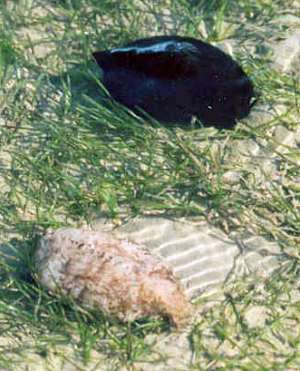
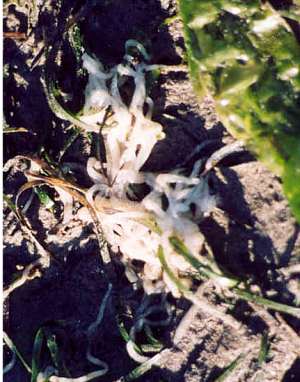
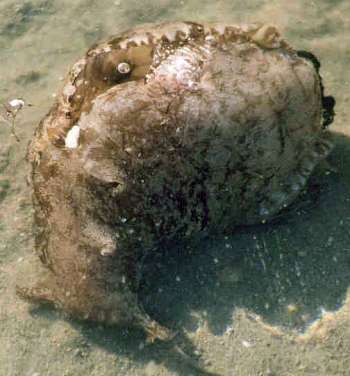
Dear Paul,
I've just returned from 2 weeks in New Zealand, but I'm afraid Tauranga and the east coast lost out to a revisit to New Plymouth and Taranaki where I lived more years ago than I care to remember.
I am pretty sure your sea hare is not A. juliana. Usually if there are different colour forms present they will be in substantial populations. I suspect you animal is what I would call Aplysia sydneyensis. Did it produce any purple ink? One major difference between A. juliana and most other sea hares is that it doesn' produce purple ink. On the other hand A. sydneyensis does. There are other external differences such as the parapodia in A. sydneyensis not joining posteriorly etc but withour the specimen it's a bit hard to check.
If I am right, this species has in recent years been identified in New Zealand as Aplysia keraudreni Rang, 1828 [Morton & Miller, 1973; Willan & Morton, 1984] but the original description of that species appears unidentifiable to me. That is not to say that the original description of Aplysia sydneyensis is much better, but at least it is localised to a species occurring in Sydney.
• Morton, J.E. & Miller, M.C. (1968) The New Zealand Sea Shore. Collins: London & Auckland. 1- 638.
• Willan, R.C. & Morton, J.E. (1984) Cape Rodney to Okakari Point Marine Reserve. Marine Molluscs Part 2. Opisthobranchia. Leigh Marine Laboratory, University of Auckland, Auckland. 106 pages.
Best wishes
Bill Rudman
Aplysia sydneyensis
November 29, 2002
From: Joan Hales
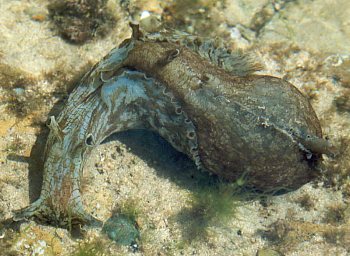
Dear Bill,
Here is a photo of Aplysia sydneyensis mating. It was photographed at Inverloch [Bass St, Victoria, Australia], where this species is very common. The two animals are different colours.
Joan Hales
Thanks Joan,
This is a species I haven't until now added to the Forum.
Best wishes,
Bill Rudman
